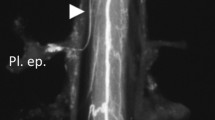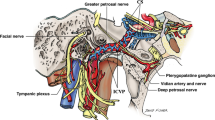Summary
Few studies have been done about the venous vascularization of the spine since neuroradiologic studies in the 1960s and 70s. The aim of this study was to clarify the topography of the internal vertebral venous plexuses in relation to the posterior longitudinal ligament and the dura. The relationships of the vv. were studied at different levels of the spine. The internal vertebral venous system of seven cadavers was injected with a blue bicomponent silicon rubber. It consisted with an anterior and a posterior venous plexus. At the cervical level, the anterior longitudinal vv. are located in a dehiscence of the periosteal layer, in the lateral part of the spinal canal. At each level, they joined the contralateral one at the midline by a retrocorporeal v. located behind the posterior longitudinal ligament. No vv. were found in the epidural space. There was a major development of the retrocorporeal v. of the axis, but it did not receive any venous drainage from the vertebral body. At the thoracic and lumbar levels, the anterior venous plexuses remain within a dehiscence of the periosteal layer, which is thinner. The retrocorporeal vv. become pre-ligamentous. We did not find any posterior venous plexuses at the cervical level, but they were evident at the thoracic level and became more voluminous and sinusoidal in the lumbar region.
Résumé
Peu d'études ont concerné la vascularisation veineuse vertébrale interne depuis l'intérêt porté par les neuroradiologues dans les années 1960–1970. Le but de cette étude est de préciser la topographie des plexus veineux vertébraux internes par rapport au ligament longitudinal postérieur et à la dure-mère. Les rapports des veines sont étudiés aux différents étages de la colonne vertébrale.
Le système veineux vertébral interne de sept cadavres a été injecté avec un élastomère de silicone bicomposant coloré en bleu. Il est constitué de deux plexus l'un antérieur et l'autre postérieur. A l'étage cervical, les veines longitudinales antérieures se situent dans un dédoublement du feuillet périosté, dans la partie latérale du canal vertébral. Elles s'anastomosent, à chaque étage, sur la ligne médiane par une veine rétro-corporéale, placée en arrière du ligament longitudinal postérieur. Nous n'avons pas retrouvé de veines dans l'espace épidural. Il existe un développement considérable de la veine rétro-corporéale de l'axis ; elle ne reçoit pas le drainage veineux du corps vertébral. A l'étage thoracique et lombaire, les plexus veineux antérieurs restent dans un dédoublement d'un feuillet périosté beaucoup plus fin. Les veines rétro-corporéales deviennent pré-ligamentaires. Nous n'avons pas retrouvé de plexus veineux postérieurs à l'étage cervical. Ils apparaissent à l'étage thoracique pour devenir plus volumineux et sinusoïdaux à l'étage lombaire.
Similar content being viewed by others
References
Bammatter S, Schnyder P, De Preux J (1987) CT in thrombosed dilated posterior epidural veins. Eur J Radiol 7: 116–118
Batson O (1957) The vertebral vein system. AJR 78: 195–212
Braun J, Tournade A (1979) Le canal de conjugaison cervical. Etude anatomo-radiologique, indication et limite des différentes techniques radiologiques. J Neuroradiol 6: 327–334
Breschet G (1819) Essai sur les veines du rachis. Méquignon-Marvis, Paris
Breschet G (1829) Recherches anatomiques physiologiques et pathologiques sur le système veineux, et spécialement sur les canaux veineux des os. Villeret, Paris
Dilenge D, Perey B (1973) An angiographic study of the meningorachidian venous system. Radiology 108: 333–337
Djindjian R, Pansini A, Dorland P (1963) Phlébographie vertébro-rachidienne par voie transépineuse. Acta Radiol 1: 689–701
Fischgold H, Clément JC, Talairach J, Escoiffier J (1952) Opacification des sytèmes veineux rachidiens et crâniens par voie osseuse. Presse Med 60: 599–601
Flannigan B, Lufkin R, McGlade C, Winter J, Batzdorf U, Wilson G, Rauschning W, Bradley W (1987) MR imaging of the cervical spine: neurovascular anatomy. AJNR 8: 27–32
Frykholm R (1952) Cervical epidural structures, periradicular and epineural sheaths. Acta Chir Scand 102: 10–20
Hayashi K, Yabuki T, Kurokawa T, Seki H, Hogaki M, Minoura S (1977) The anterior and posterior longitudinal ligaments of the lower cervical spine. J Anat 124: 633–636
Kubo Y, Waga S, Kojima T, Matsubara T, Kuga Y, Nakagawa Y (1994) Microsurgical anatomy of the lower cervical spine and cord. Neurosurgery 34: 895–902
Lazorthes G, Gouazé A, Djindjian R (1973) Vascularisation et circulation de la moelle épinière. Masson, Paris, pp 109–125
Plaisant O, Cosnard G, Gillot C, Schill H, Lassau JP (1994) MRI of the epidural space after Gelatin/Gadolinium venous injection. Surg Radiol Anat 16: 71–75
Plaisant O, Sarrazin JL, Cosnard G, Schill H, Gillot C (1996) The lumbar anterior epidural cavity: the posterior longitudinal ligament, the anterior ligaments of the dura mater and the anterior internal vertebral venous plexus. Acta Anat 155: 274–281
Renard M, Masson J, Lardé D (1976) Les veines épidurales lombaires (étude anatomique à propos de 31 cas). Bull Ass Anat 60: 787–800
Scapinelli R (1990) Anatomic and radiologic studies on the lumbosacral meningovertebral ligaments of humans. J Spinal Disord 3: 6–15
Schobinger R, Lessmann FP (1957) A new approach allowing the roentgenologic demonstration of the cervical vertebral venous plexi. Exp Med Surg 15: 289–294
Tadié M, Hemet J, Aaron C, Bianco C, Creissard P, Huard P (1979) Le dispositif antireflux des veines de la moelle. Neurochirurgie 25: 28–30
Théron J, Djindjian R (1973) Techniques de phlébographie rachidienne cervicale par cathétérisme. J Radiol 54: 105–111
Trolard P (1892) Les sinus et les veines de la cavité rachidienne. Alger
Vogelsang H (1970) Anatomy and physiology of the venous system of the vertebral column. In: Vogelsang H (ed) Intraosseous spinal venography. Excerpta Medica, Amsterdam, pp 7–19
Walther B (1885) Recherches sur les veines du rachis. Thèse, Paris
Wiltse L, Fonseca A, Amster J, Dimartino P, Ravessoud F (1993) Relationship of the dura, Hofmann's ligaments, Batson's plexus, and a fibrovascular membrane lying on the posterior surface of the vertebral bodies and attaching to the deep layer of the posterior longitudinal ligament. An anatomical, radiologic, and clinical study. Spine 18: 1030–1043
Zadeh J, Lazorthes G, Roux P, Laveran A (1989) Le feuillet périostique rachidien et l'étui fibreux du canal de conjugaison cervical. Bull Ass Anat 73: 45–47
Author information
Authors and Affiliations
Rights and permissions
About this article
Cite this article
Chaynes, P., Verdié, J.C., Moscovici, J. et al. Microsurgical anatomy of the internal vertebral venous plexuses. Surg Radiol Anat 20, 47–51 (1998). https://doi.org/10.1007/BF01628115
Received:
Accepted:
Issue Date:
DOI: https://doi.org/10.1007/BF01628115




